REPRINTED WITH PERMISSION FROM THE CHRISTIAN SCIENCE MONITOR
As poaching soars across Namibia, one community hasn’t lost a rhino to poachers in three years. How’d they do it? By working with the community.
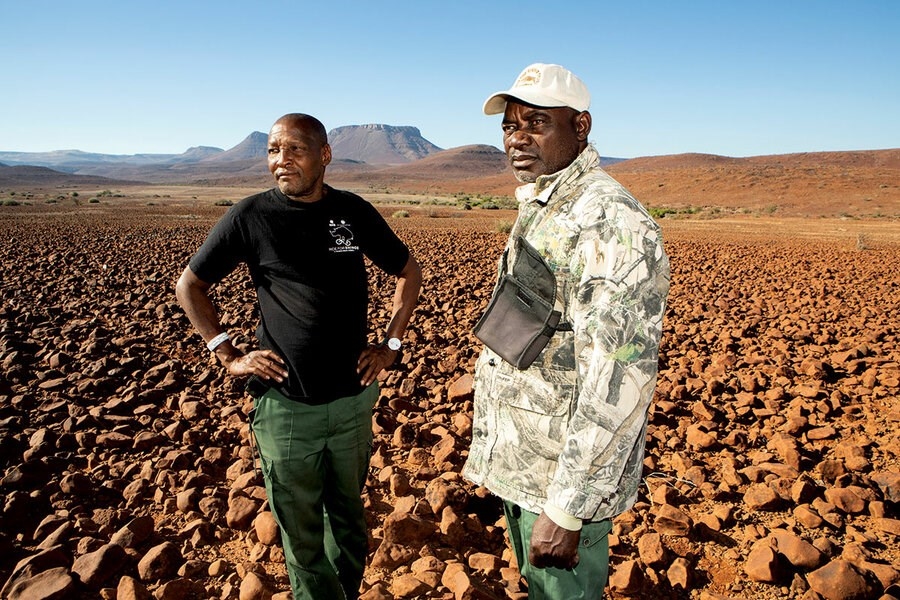 Melanie Stetson Freeman/StaffEbson Mbunguha (right) and Sebulon Hoeb track rhinos in the Torra Conservancy near Palmwag, Namibia.
Melanie Stetson Freeman/StaffEbson Mbunguha (right) and Sebulon Hoeb track rhinos in the Torra Conservancy near Palmwag, Namibia.
| PALMWAG, NAMIBIA - The rhino trackers trek a mile into the open desert plains of northwest Namibia. They stop 300 feet from a desert-adapted black rhinoceros grazing on the rocky hillside.
Rhinos have poor eyesight, so the windy day works in the trackers’ favor, making it harder for the animals to locate them by sound or smell. Sebulon Hoeb, the principal field officer of Save the Rhino Trust Namibia, wants to get closer, but his partner today, Ebson Mbunguha, has his binoculars trained at the distance. He tells the group to back away. He has identified this rhino: Matty 2. She is 4 years old, which means her mother probably has a new baby and could appear on the open plain at any moment. There are no trees to climb if the crew is suddenly surrounded by creatures that can weigh as much as 3,000 pounds.
Plus, they’ve identified her. Their job is now done.
Every day and every night, trackers from Save the Rhino Trust, alongside rangers from the local community, patrol 25,000 square kilometers (just under 10,000 square miles) in Namibia’s northwest, the only place in the world where this desert-adapted subspecies of the black rhino is still truly wild. Even if these animals are spotted from a distance, the trackers know them so well that they can identify them from their behaviors, roaming patterns, and physical features like birthmarks. It’s all documented on small pieces of paper that pile up back at Save the Rhino Trust headquarters in the pinprick of a town, Palmwag.
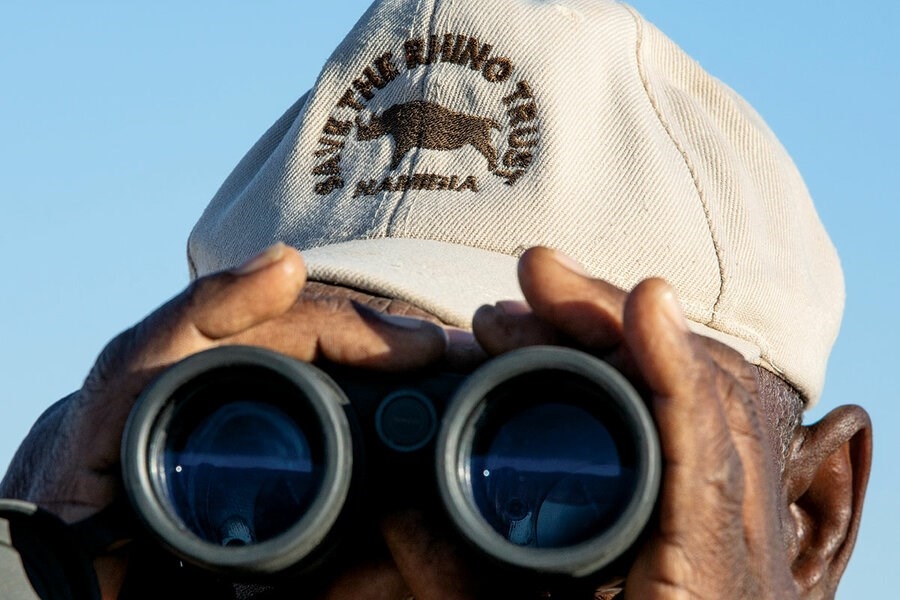 Melanie Stetson Freeman/StaffEbson Mbunguha scans for rhinos through binoculars.
Melanie Stetson Freeman/StaffEbson Mbunguha scans for rhinos through binoculars.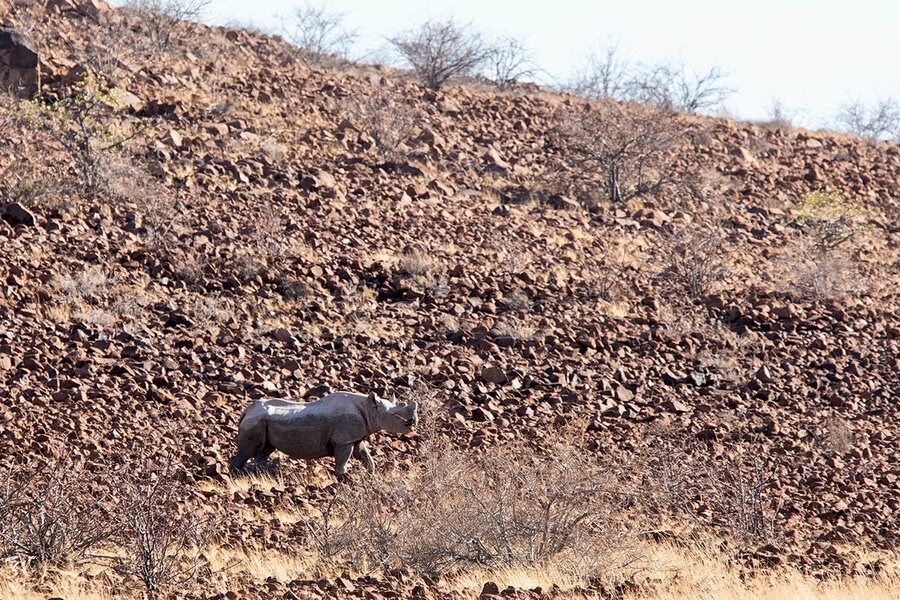 Melanie Stetson Freeman/StaffA female rhinoceros named Matty 2 forages for food on the hillside.
Melanie Stetson Freeman/StaffA female rhinoceros named Matty 2 forages for food on the hillside.
The trackers are not just building a living database of conservation or scientific study; patrolling is the best tool they have against rhino poaching. And the work is paying off.
Rhino conservationists discourage publishing the price of horns on the black market, in order to deter criminal activity, but rhino horns are in high demand, especially in China and Vietnam. After years of successfully clamping down, Namibia saw rhino poaching increase by 93% last year over the year before, according to the Ministry of Environment, Forestry and Tourism. But here the community hasn’t logged a rhino poaching in three years. That’s because, within the structures of Namibia’s community conservation model, safeguarding the animals is more lucrative than selling them on the illegal market. It’s an ultimate win-win.
“Most of us understand that the rhino pays us,” Mr. Hoeb explains plainly.
The desert-adapted rhino, one of the oldest mammals on Earth, has roamed this arid, red-earth region that glows at sunrise and sundown for millennia. Its presence is depicted in the ancient cave art found in nearby Twyfelfontein, a UNESCO World Heritage Site.
But in the 20th century, European hunting all but eradicated its numbers. Between 1960 and 1995, black rhino numbers dropped by 98% to fewer than 2,500.
Save the Rhino Trust was established in 1982, when only 50 black rhinos roamed this area. Forty years later, Namibia hosts almost 35% of the world’s remaining black rhino population, although the exact number is tightly guarded. “That’s a state secret,” says Simson Uri-Khob, the CEO who has dedicated his career to saving the rhino.
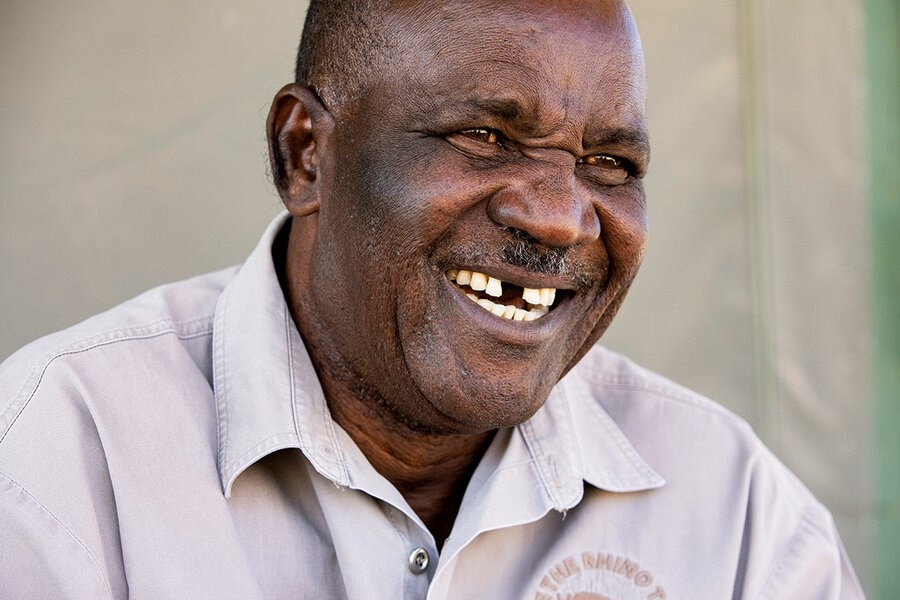 Melanie Stetson Freeman/Staff“We are proud because the rhinos are here, but they are not everywhere. We managed ours from near extinction.” – Simson Uri-Khob, a CEO who has dedicated his career to saving the rhino
Melanie Stetson Freeman/Staff“We are proud because the rhinos are here, but they are not everywhere. We managed ours from near extinction.” – Simson Uri-Khob, a CEO who has dedicated his career to saving the rhinoWhen Namibia gained its independence in 1990, it became the first country in Africa to protect the environment in its constitution. It also created community conservancies – lands with defined borders and governances outside the national park structure, where the communities themselves benefit from the resources, including animals, on their homelands. Today the government counts 86 communal conservancies covering more than 20% of the country’s territory. Many of these conservancies thrive by running lodges that draw tourists to see wildlife, in turn fueling local economies.
Steve Galloway, chairman of the Community Conservation Fund of Namibia, says community conservation represents the best of both worlds. It puts large tracts of land under environmental protection – but not at the expense of people. “You bring in tourists, and you grow vegetables for those tourists and curios for those tourists. You do hiking trails, and you create a whole ecosystem,” he says.
In other words, here in Palmwag, everyone is vested in the sighting of Matty 2.
Waatara Karutjaiva, a server at Palmwag Lodge, has found steady work here for seven years. At the lodge, tourists from around the world laze around two pools looking out at flat-topped mountains and makalani palms, after spending around $150 for a half-day rhino-trekking tour. “The rhinos attract the white people, and that gives us jobs,” says the mother of three, whose father and brother also work at Save the Rhino Trust. “We all care about rhino conservation here.”
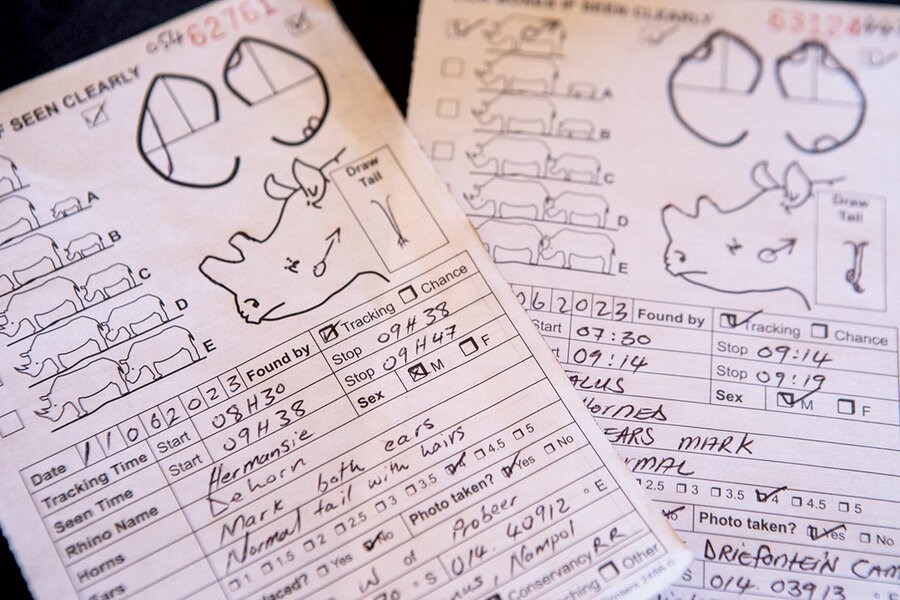 Melanie Stetson Freeman/StaffForms filled out by rangers identify rhinos observed by name.
Melanie Stetson Freeman/StaffForms filled out by rangers identify rhinos observed by name.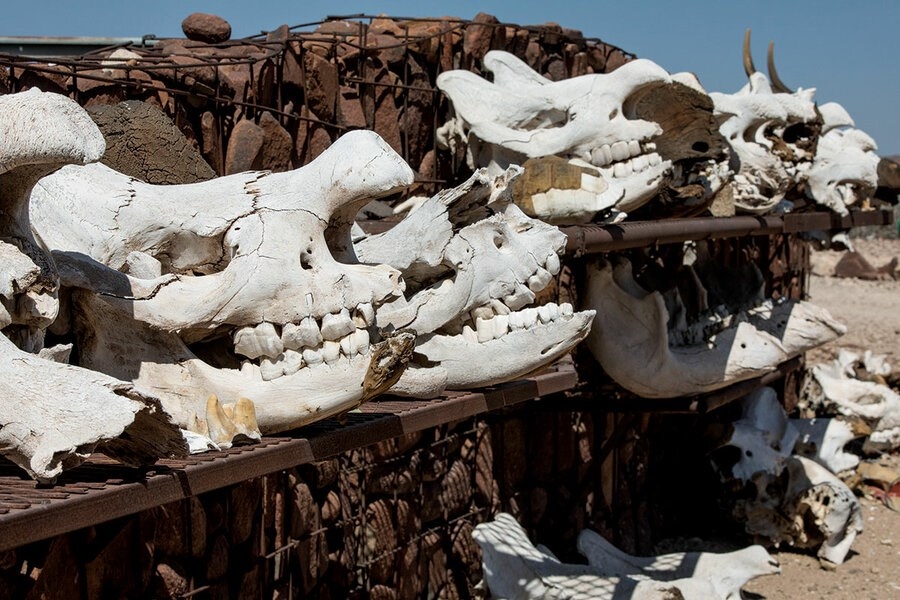 Melanie Stetson Freeman/StaffRhino skulls from animals that died naturally line a stone wall at Save the Rhino Trust headquarters in Palmwag.
Melanie Stetson Freeman/StaffRhino skulls from animals that died naturally line a stone wall at Save the Rhino Trust headquarters in Palmwag.
But they remain on guard. Prolonged drought and encroachment from mining are disrupting wildlife populations. And even though overall rhino numbers are up, so is the threat of poaching. Last year 87 were killed, with the problem concentrated in Etosha National Park. Wilburd Andreas Rasta has worked as a game guide for 16 years and has never seen pressure like this. “As we are speaking, they are poaching,” he says.
In Etosha, it is the military and police that patrol the area; to address the increased threats, they’ve recently expanded patrols to include horseback personnel and implemented more high-tech surveillance. But for Save the Rhino Trust, it’s the community that forms the foundation of surveillance to protect its rhinos. “Everybody knows me. Everybody has got my cellphone number,” says Mr. Uri-Khob. “It’s a very busy cellphone, this one.”
“Community conservancies in Namibia are groundbreaking and incredibly powerful and positive, and really leading the way in bringing people who live with wildlife to have a meaningful participation in the way that wildlife is managed,” says Jo Shaw, CEO of the United Kingdom’s Save the Rhino International (a separate organization in Namibia). “It’s just such an important and positive model for Africa ... creating that positive link between people and wildlife that is so often missing elsewhere.”
Dr. Shaw argues that rhinos are important not just unto themselves, but also because they are a keystone species. Their health means that other species are also safe and that the ecosystems that they need to survive are intact.
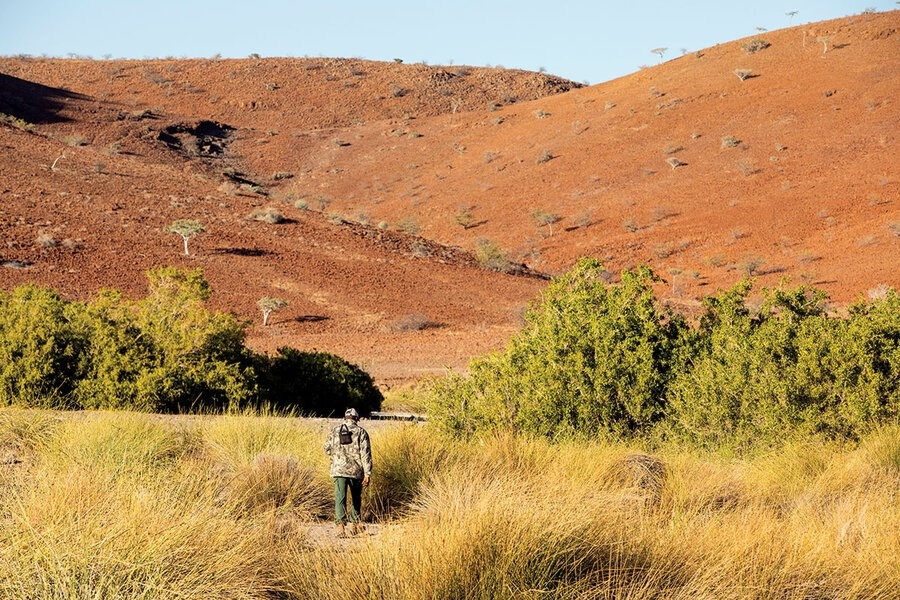 Melanie Stetson Freeman/StaffEbson Mbunguha looks for rhino tracks and dung.
Melanie Stetson Freeman/StaffEbson Mbunguha looks for rhino tracks and dung.The rhino rangers start the day under a starry southern sky in the Namibian desert, driving through places called “Rhino Valley” or “Poacher’s Camp.” Mr. Mbunguha gets out of the car to identify footprints in the dusty earth. He quickly determines that they are old. The rangers drive up to a ridge overlooking a canyon dotted with the Damara milk-bush that protrudes from the barren red earth in clusters of green-gray – poisonous to most animals but not to rhinos. From the back of the truck, police officer Naftal Nambambi is scanning the distance to protect against poachers who are a danger to both the animals and the rangers.
It’s no easy job. A 24/7 operation demands that the rangers live in tents for three weeks at a time, doing most of their tracking on foot. They get a bonus for how many kilometers they walk and how many sightings they log. It can be dangerous. “I’ve had to run for my life many times,” says Mr. Hoeb. He and Mr. Uri-Khob, who have worked together for years, once were chased and had to hide under the toxic milk-bush (quickly finding a stream to wash off the toxins when it was safe).
Mr. Uri-Khob, who won the Prince William lifetime achievement award in 2021 in recognition of a career dedicated to conservation, says that this work is not just about the local economy.
When he focused his master’s degree on the reintroduction of the black rhino in its historical range, he asked community members hundreds of questions to gauge their attitudes. He found that the people here are simply attached to a creature that has always roamed this land. “We are proud because the rhinos are here, but they are not everywhere,” he says. “We managed ours from near extinction.”
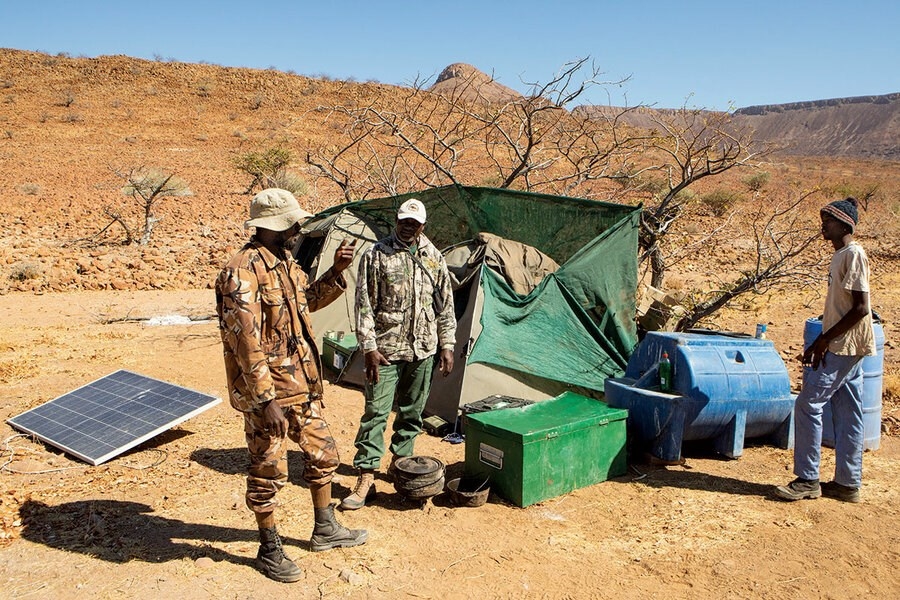 Melanie Stetson Freeman/StaffThree men will stay at this ranger camp for 20 days while tracking and recording rhinoceroses on foot.
Melanie Stetson Freeman/StaffThree men will stay at this ranger camp for 20 days while tracking and recording rhinoceroses on foot.
Everyone has a story about a rhino. Mr. Uri-Khob has one, too.
He recalls a 6-year-old rhinoceros that stood in the middle of the Namibian desert, during one of their workdays. The young bull approached the group of game guards and stared them in the eyes; it then did a little flip with its body to turn itself around, walked back, and then flipped around again to meet their eyes. It was a move they’d never seen before, or since.
Mr. Uri-Khob was charmed by the show, and what seemed like its nonchalance in the face of humans. He named the rhino Don’t Worry, and tracked his movement and growth over 30 years.
When Don’t Worry died, in 2020, it was of natural causes – not at the hands of a poacher.
Page created on 2/5/2024 2:01:32 PM
Last edited 2/5/2024 3:22:53 PM
